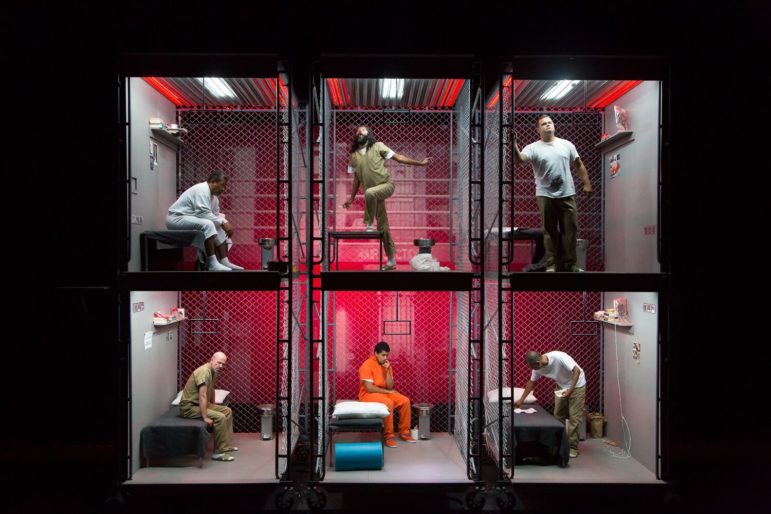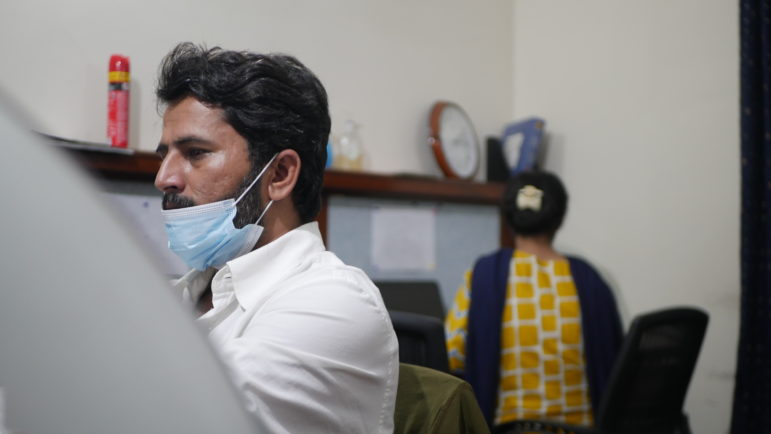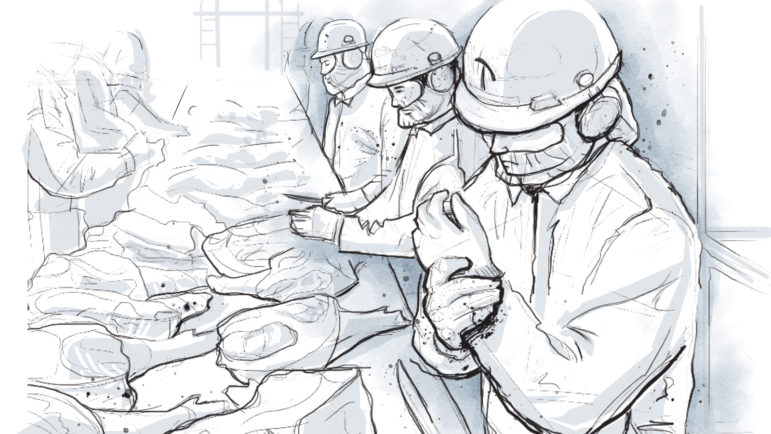

Using Theater—and Zoom—to Tell Stories of Investigations into Solitary Confinement
There is no curtain to raise. Viewers sit alone in their living rooms, bedrooms, and offices in London, Chicago, and Sydney, waiting. After a few seconds of darkness, four boxes emerge, three framing the jawlines of men who have been jailed next to one another in a Solitary Housing Unit for years. In the fourth box, is the new arrival, Rocky, whose face is plastered with fear and confusion and who responds to the taunts of the other men with a blend of bravado and terror.
So begins “The BOX,” a play about solitary confinement in the United States, written by Sarah Shourd, whose work often sits at the intersection of journalism, art, and activism and whose name made international headlines after she was taken captive by Iran while hiking near the border.
As a journalist and writer, Shourd has worked on telling stories of solitary confinement for the better part of ten years, with outlets like the Daily Beast, Mother Jones, and The New York Times publishing her reporting. “The BOX” draws on Shourd’s deep investigation into solitary confinement, fictionalizing the stories of a dozen people that she has written to and visited over several years.
She takes inspiration from investigative projects like Matthew Desmond’s dive into housing insecurity in Milwaukee, Wisconsin, in his book “Evicted“ and Seyward Darby’s more recent “Sisters in Hate,” which tells the stories of three white nationalist women. Shourd also admires projects like “Unbelievable,” the Netflix adaptation of a 2015 ProPublica and Marshall Project investigation into a rape case.
“The BOX” features actors who have converted corners of their homes into ad-hoc theaters, lit with the cold fluorescent light of institutions; the play transmitted over the video conferencing application Zoom. It is a work of theater that continues to evolve and adapt to new forms and circumstances — but Shourd never expected to stream the play to audiences worldwide already experiencing the isolation caused by the COVID-19 pandemic.
“You’re being connected despite the fact that we’re in the middle of this global pandemic that has really isolated us in a way that we’ve never been isolated before,” she said. “The more audiences we can reach, the more impact we can have with our work.”
In the play, Shourd blends fact and fiction to communicate an intimate and emotional truth. In exploring non-traditional ways of presenting and communicating in-depth reporting and research, Shourd hopes not just to reach broader audiences, but to present alternative ways to learn about and react to the reality of solitary confinement in the US. Through theater, Shourd sees a way to build a depth of empathy difficult to achieve in more conventional journalistic storytelling.
“You have to be able to imagine yourself into that person’s experience,” she said. “They can’t be something sort of distant and intellectual.”
An Idea Born of an Iranian Prison Cell
The research and work that underpin “The BOX” began for Shourd as a way to heal. In 2009, she and two friends were captured by Iranian forces on a hiking trip in northern Iraqi Kurdistan. Their capture turned into a high-profile diplomatic affair, in which Iranian officials accused Shourd and her companions of espionage, despite a lack of evidence. Shourd spent the entirety of her imprisonment, 410 days, in isolation.
After a negotiated release, Shourd returned to the US but found the solitude of that experience profoundly isolating. She felt an acute need to understand what had happened to her, how she had survived it, and the scars she still carried from spending over a year alone in a cell. No one in her circle could identify with what she had been through, and she had no community that she could share with to help her process her trauma.
“I needed to funnel my own pain into something bigger than myself,” she said. “I also needed a community to — or a movement to — connect to, so that I wasn’t doing it alone.”
In part out of a desire to create a community of survivors, in part out of rage that what she experienced was commonplace in prisons and jails across the country, Shourd started to report on solitary confinement from home.
Through groups like Solitary Watch, she began to find a community and a movement, and what she learned astonished and outraged her. An estimated 80,000 to 100,000 people experience solitary confinement in the US on a given day. Prisons and jails can keep people in isolation for years, subjecting them to a practice the United Nations considers torture. There are no trials or juries when a guard or a warden decides to use solitary confinement as a punishment.
“Solitary confinement is the deep end of the whole system of mass incarceration,” Shourd said. “It really shows the failing of not only the whole system, but our whole society, when it comes to mental illness, and how to really deal with and prevent cycles of violence.”
Shourd began to reach out to people in solitary confinement across the US. She wrote letters, connected with advocacy groups, and visited institutions. She held a position as a visiting scholar at the University of California, Berkeley, for three years, which helped to support her deep investigation into isolation as punishment.
Shourd connected with about 75 people imprisoned in institutions in 15 states, and visited many in person. Twelve committed to exchanging regular letters, phone calls, and visits. As Shourd continued her investigative work, she didn’t know what the outcome or final product would be, but she wanted to collect as much as she could.
It wasn’t until Jean Casella from Solitary Watch, a watchdog group, suggested theater as a format that Shourd began transforming her research into a play.
“It’s a little bit of an absurd endeavor,” Shourd said of the decision to write a play about solitary confinement. “Solitary confinement is defined by the absence of life. And theater is all about action.”
But theater and art were not new to Shourd, and she saw enormous potential in telling a story about solitary confinement through such an active and close medium.
“[With theater] you’re literally in proximity of the physical body of a person that is a conduit of these stories,” she said. “The cognitive distance is decreased significantly.”
Throughout her investigation, Shourd reported on solitary confinement, but says that while she values and appreciates journalism’s relentless focus on the facts, she felt the strategies of strictly journalistic storytelling would struggle to communicate the emotional reality of solitary confinement. She began to blend reality and fiction and started writing “The BOX.”
Shourd takes inspiration from creators like illustrator and reporter Molly Crabapple, artist Laurie Jo Reynolds, and the writer Katherine Boo. Projects like Graphic News in Italy and ProPublica’s Heartsaver have explored creative approaches to more strictly journalistic storytelling, too. By using tools like graphic novels, illustration, and interactive games, these strategies share Shourd’s commitment to not only reaching new audiences, but telling stories through a variety of dynamic and engaged media. She calls it “journalism-inspired.”
“We absolutely have to dive deep into reality,” Shourd said. “And then there’s no reason why that can’t be wed to the most powerful storytelling possible and brought to new audiences in a different way.”
In the midst of her investigative process, a hunger strike began at Pelican Bay State Prison in northern California. Spreading across the prison system, thousands of those incarcerated across the state refused food for weeks at a time. A smaller group did not eat for about two months.
Shourd communicated with several people involved, and a few of the organizers that lit the fuse at Pelican Bay, and realized the events could provide a narrative arc to the sweeping story she wanted to tell about solitary confinement.
From the Theater to Your Living Room
Z Space in San Francisco, which often supports emerging artists, hosted the first performance of “The BOX” in 2016. It had a cast of nine in a two-act production replete with heavy sound design intended to underscore the emotional trauma of solitary confinement.
After the production closed, Shourd realized she had to pare down the play if she wanted to bring it to more audiences, so began working on a very different kind of production, cutting the cast down to five, and re-configuring it to be more mobile and adaptable.
In 2019, she brought the revised work to Alcatraz Island, the site of a former federal prison, where she had to work within a wholly different context. She geared that production towards people who had experienced solitary confinement and their families, performing a quieter, more intimate version of the play for a much smaller audience, who often took part in a discussion after the show.
Shourd never planned to produce the play for a remote audience over Zoom, and when Nathalie Applewhite, the managing director of the Pulitzer Center, which began to fund Shourd’s work during the Alcatraz production, first suggested reworking the production, she recoiled.
“My first reaction to the idea of doing theater on Zoom was a really visceral no,” Shourd said. “It seemed gimmicky to me.”
She worried the collective witness that unfolds in the shared space of a theater would vanish in a digital format. To her, theater finds its value in presence and a shared moment in time and space. Creating that experience over Zoom felt not just difficult but harmful.
But Shourd kept thinking about it and started to see it as an opportunity. What’s more, the shared experience of a pandemic that has forced many of us to spend far more time inside our homes and alone than ever before began to seem — in and of itself — like a way to access something like the collective witness that drew Shourd to theater in the first place.
She began to think about how to use the Zoom display to lend perspective and depth to the performance. She envisions them as the slot in a cell door that people in solitary confinement communicate through: a window out for them, a close and intimate window in for the audience. We get close to the actor’s dimples, wrinkles, and spit as they perform the play. We never see their full bodies, just segments of their selves and cells.
The play ran on Zoom three times, with a follow-up conversation with Shourd and one of the actors, Dameion Brown, after the final performance. Brown plays Ray in the play, a member of the Black Panthers, a Black Power political organization active during and after the US Civil Rights Movement, and a character who has been punished with 19 years of solitary confinement.
Brown, who was himself punished with solitary confinement while he was incarcerated as a younger man, turned to the theater after his release, performing with the Marin Shakespeare Company, among others.
His co-star, Terrance Smith, who plays Rocky, found deep resonance in performing in this play over Zoom as the pandemic pushes many of us into unfamiliar isolation. He converted a corner of his parents’ house into a staged cell.
“[There is] Something within that resonates to… people being in their own exclusive boxes, not truly being able to have human connection, and just that yearning for it,” Smith said.
For now, Shourd doesn’t anticipate further digital performances of “The BOX,” instead planning a mobile roadshow called the “End of Isolation Tour,” which she hopes will happen as soon as a COVID-19 vaccine becomes available. That production will be another lesson in how to find connection within a new set of constraints.
“No matter what you do to people, no matter how hard you try to cut them off from anything to any kind of connection, any kind of meaningful work or existence in the world, people find a way,” she said. “People have just an incredible desire to connect with each other.”
Editor’s Note: This article originally referred to the The ProPublica investigation as Heartland. The correct name of the investigation is Heartsaver.
Additional Reading
Double Exposure: 5 Investigative Documentaries to Watch
A Global Tour of Top Investigative Podcasts: The 2020 Edition
 Nina Sparling is a journalist and audio producer based in San Francisco. She reports on inequality and resources. Her writing has been published by The Paris Review, The New York Times, and Vogue and her audio work broadcast by NPR and Capital Public Radio in the US.
Nina Sparling is a journalist and audio producer based in San Francisco. She reports on inequality and resources. Her writing has been published by The Paris Review, The New York Times, and Vogue and her audio work broadcast by NPR and Capital Public Radio in the US.













